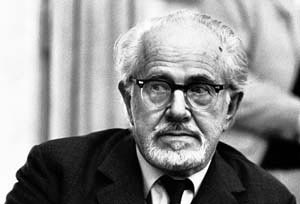| Mark Tobey | |
|---|---|
 |
|
| Born | Dec. 11, 1890 Centerville, Wisconsin |
| Died | Apr. 24, 1976 (at age 85) Basel, Switzerland |
| Nationality | American |
| Education | Art Institute of Chicago |
| Movement | Abstract Expressionism Northwest School |
| Field | Painting |
| Works | View Complete Works |
Mark Tobey (1890-1976) was an American painter who may be considered part of the Abstract expressionist movement, thanks to the dense detail and intricate structure portrayed in his works. However, he did not subscribe to the movement’s more usual philosophies, instead helping to found the Northwest School. Tobey became widely known both in his home country and in Europe for his works, which demonstrate a strong interest in Asian mysticism. He also wrote a certain amount of both poetry and music.
Personal Life
Born in the very small town of Centerville in rural Wisconsin, Tobey was by some distance the youngest in a family containing four children; his mother had already passed her fortieth birthday when her son was born. His father, George Tobey, worked as a house builder and carpenter. In his spare time, he made carved stone animals for young Mark, as well as drawing pictures of animals that he could cut out for himself. Tobey was not particularly influenced by his home town, as the family moved to Chicago – then a rapidly expanding city – in 1893.
When he was in his late teens, Tobey spent two years as a student at the Art Institute of Chicago. This was his only formal artistic education; along with his colleagues in the Northwest School, he learned most of his artistic skills and means of expression for himself. He was briefly married when around 30 – the exact details are obscure – but for the most part, Tobey remained a bachelor. He did, however, live with Pehr Hallsten for a quarter of a century up until his death in 1976. Perhaps partly to forget his failed marriage, he moved frequently around the world, finally settling in Switzerland just one year before he died.
Artistic Development
Tobey’s first professional job as an artist was as an illustrator of fashion pieces for McCall’s magazine in New York. He supplemented his somewhat meager income with a side job painting portraits, and in 1917 he was able to hold his first solo show in Manhattan. The following year, he met Juliet Thompson, who influenced him to convert to the Baha’i faith. This was to prove a very significant influence on Tobey’s work, as he not only studied Asian philosophical teachings and read Eastern literature, but also became fascinated by the way in which spiritualism could be represented on the canvas.
The 1920s saw Tobey travel widely: he met Gertrude Stein in Paris, visited Barcelona, and made a study of Eastern writing on trips to the Near East. He returned to the United States in 1927, where he took a studio in conjunction with the much younger Robert Bruce Inverarity. The young artist’s high school project intrigued Tobey so much that he carved around a hundred soap-based pieces, before his desire for constant change again got the better of him. In 1928, he helped to set up Seattle’s Free and Creative Art School, and in the 1930s he developed the “white writing” technique which was to become his most famous style. Thereafter, his style developed more gradually, apart from the increased level of abstraction in his works after the 1940s.
Notable Works
Tobey’s semi-abstract “white writing” technique was notably employed in the 1954 painting Canticle. To produce this painting, he first laid down a background, made up of many hundreds of tiny, interwoven strokes. He then overlaid this with light, sometimes completely white, symbols given the appearance of calligraphy. Jackson Pollock’s own, slightly later, “all-over” style is often considered to be, at least in part, a development and refinement of the style that Tobey pioneered. Tobey also made use of the effects of Brownian motion in order to give his painting the impression that the space within it was vibrating, which in turn made them seem highly mobile and dynamic.
Among Tobey’s most important earlier works are the three paintings in his Broadway set, produced in late 1935. These constituted his first major “white writing” paintings, and were strongly influenced by the Baha’i faith that he had by then entirely embraced. Tobey experimented a little more in the last years of his life, during which he was granted retrospective shows of his already impressive body of work. The 1971 brown aquatint Thanksgiving Leaf, made using a technique with similarities to etching, used a small canvas – a mere nine inches by six. Within that space, however, a remarkable vigor was achieved by the use of repeated, broad-brush swirls having almost the appearance of worm casts.